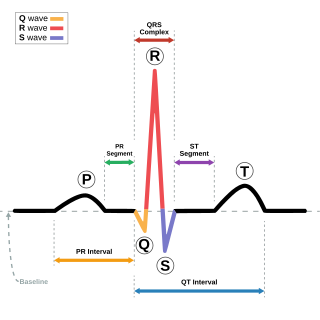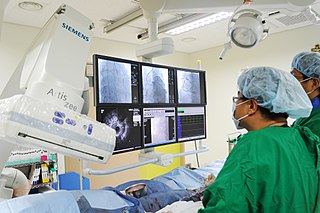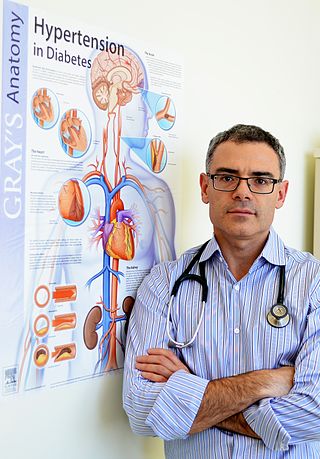This article needs additional citations for verification .(March 2023) |
Electroanatomic mapping is a method of creating a three dimensional model of the human heart during clinical cardiac electrophysiology procedures.
This article needs additional citations for verification .(March 2023) |
Electroanatomic mapping is a method of creating a three dimensional model of the human heart during clinical cardiac electrophysiology procedures.
The fundamental concept of electroanatomic mapping systems is to localize catheters within the heart in three dimensional space (a sort of "GPS" within the heart). Building a 3-D model of the heart with real-time visualization permits reduction in fluoroscopy use. In addition to 3-D structure, the voltage and timing of signals at each point of the heart is recorded to generate different maps to understand and treat different rhythm disturbances.
Each of the three systems utilizes different techniques to localize catheters: [1]
There are three electroanatomic mapping systems commercially available.
Biosense-Webster, a subsidiary of Johnson & Johnson, produces a cardiac electrophysiology system called CARTO. [2] The system is designed to visualise the real-time calculated position and orientation of a specialised RF ablation catheter within the patient's heart in order to minimise radiation exposure during fluoroscopy, increase the accuracy of targeted RF ablation and reacquisition of pacing sites for re-ablation. [3] Its navigation system calculates the position and orientation of the catheter tip, using three known magnetic sources as references. The system uses static magnetic fields that are calibrated and computer controlled. Due to the nature of magnetic fields, the orientation may also be calculated while the tip is stationary. By calculating the strength and orientation of the magnetic fields at a given location, the x,y,z position may be calculated along with the roll, pitch, yaw orientation. [2]
St. Jude Medical, now a part of Abbott, manufactures EnSite family of cardiac mapping systems, the latest edition being EnSite Precision, which allows speedy heart mapping during catheter ablation with better accuracy to be able to treat cardiac rhythm disturbances. [4]
Rhythmia is a mapping system developed by Boston Scientific. It has changed names to Opal. [5]
Mapping systems generate three kinds of data:

Electrocardiography is the process of producing an electrocardiogram, a recording of the heart's electrical activity through repeated cardiac cycles. It is an electrogram of the heart which is a graph of voltage versus time of the electrical activity of the heart using electrodes placed on the skin. These electrodes detect the small electrical changes that are a consequence of cardiac muscle depolarization followed by repolarization during each cardiac cycle (heartbeat). Changes in the normal ECG pattern occur in numerous cardiac abnormalities, including:

A pacemaker, also known as an artificial cardiac pacemaker, is an implanted medical device that generates electrical pulses delivered by electrodes to one or more of the chambers of the heart. Each pulse causes the targeted chamber(s) to contract and pump blood, thus regulating the function of the electrical conduction system of the heart.

Cardiac electrophysiology is a branch of cardiology and basic science focusing on the electrical activities of the heart. The term is usually used in clinical context, to describe studies of such phenomena by invasive (intracardiac) catheter recording of spontaneous activity as well as of cardiac responses to programmed electrical stimulation - clinical cardiac electrophysiology. However, cardiac electrophysiology also encompasses basic research and translational research components. Specialists studying cardiac electrophysiology, either clinically or solely through research, are known as cardiac electrophysiologists.

Cardiac catheterization is the insertion of a catheter into a chamber or vessel of the heart. This is done both for diagnostic and interventional purposes.

Catheter ablation is a procedure that uses radio-frequency energy or other sources to terminate or modify a faulty electrical pathway from sections of the heart of those who are prone to developing cardiac arrhythmias such as atrial fibrillation, atrial flutter and Wolff-Parkinson-White syndrome. If not controlled, such arrhythmias increase the risk of ventricular fibrillation and sudden cardiac arrest. The ablation procedure can be classified by energy source: radiofrequency ablation and cryoablation.
Clinical cardiac electrophysiology, is a branch of the medical specialty of cardiology concerned with the study and treatment of rhythm disorders of the heart. Cardiologists with expertise in this area are usually referred to as electrophysiologists. Electrophysiologists are trained in the mechanism, function, and performance of the electrical activities of the heart. Electrophysiologists work closely with other cardiologists and cardiac surgeons to assist or guide therapy for heart rhythm disturbances (arrhythmias). They are trained to perform interventional and surgical procedures to treat cardiac arrhythmia.

Michel Haïssaguerre is a French cardiologist and electrophysiologist. His investigations have been the basis for development of new markers and therapies for atrial and ventricular fibrillation.
The Sensei X robotic catheter is a medical robot designed to enhance a physician’s ability to perform complex operations using a small flexible tube called a catheter. As open surgical procedures that require large incisions have given way to minimally invasive surgeries in which the surgeon gains access to the target organs through small incisions using specialized surgical tools. One important tool used in many of these procedures is a catheter used to deliver many of things a surgeon needs to do his work, to impact target tissue and deliver a variety of medicines or disinfecting agents to treat disease or infection.

Atrial fibrillation is an abnormal heart rhythm (arrhythmia) characterized by rapid and irregular beating of the atrial chambers of the heart. It often begins as short periods of abnormal beating, which become longer or continuous over time. It may also start as other forms of arrhythmia such as atrial flutter that then transform into AF.

A cardiac electrophysiology study is a minimally invasive procedure using catheters introduced through a vein or artery to record electrical activity from within the heart. This electrical activity is recorded when the heart is in a normal rhythm to assess the conduction system of the heart and to look for additional electrical connections, and during any abnormal heart rhythms that can be induced. EP studies are used to investigate the cause, location of origin, and best treatment for various abnormal heart rhythms, and are often followed by a catheter ablation during the same procedure.

Henrick Joan Joost Wellens, M.D., (1935–2020) was a Dutch cardiologist who is considered one of the founding fathers of clinical cardiac electrophysiology - a discipline which enables patients with cardiac arrhythmias to have catheter electrode mapping and ablation.
Stereotaxis Inc. is an American publicly traded corporation based in St. Louis, Missouri, that makes robotic products to try to improve the clinical outcomes of electrophysiology studies.

Topera, Inc. is a cardiac arrhythmia mapping company for targeting catheter ablation company launched in San Diego, California and specializes in mapping electrical signals of the heart. Topera's headquarters are located in Palo Alto, California. The company uses 3D analysis and mapping to detect the sources of atrial fibrillation, atrial flutter, and atrial tachycardia and ventricular tachycardia to identify targets for catheter ablation.

Yaariv Khaykin is a Canadian cardiologist and a clinical researcher in the area of electrophysiology. He is the director of the Newmarket Electrophysiology Research Group at the Southlake Regional Health Centre. He has published research into complex ablation and pioneered cardiac ablation methods.
Robotic magnetic navigation (RMN) uses robotic technology to direct magnetic fields which control the movement of magnetic-tipped endovascular catheters into and through the chambers of the heart during cardiac catheterization procedures.
Bruce B. Lerman is a cardiologist. He is the Hilda Altschul Master Professor of Medicine at Weill Cornell Medical College, and was chief of the Division of Cardiology and director of the Cardiac Electrophysiology Laboratory at Weill Cornell Medicine and the New York Presbyterian Hospital.
Sanjiv M. Narayan is a British-born American physician, biomedical engineer, and academic researcher. He is a Professor of Medicine at Stanford University. Narayan's work is focused on treating patients with heart rhythm disorders, particularly those with atrial fibrillation. His research applies bioengineering and computational methods to develop improved diagnostic tools and therapy.
Intracardiac echocardiography (ICE) is a specialized form of echocardiography that utilizes an ultrasound-tipped catheter to perform imaging of the heart from within the heart. Unlike transthoracic echocardiography (TTE), ICE is not limited by body habitus. An ICE catheter is inserted into the body, typically, through the femoral vein and advanced into the heart.
Ganglionated plexi (GP) comprise the intrinsic cardiac autonomic nervous system composed of autonomic ganglia of the heart atrium and ventricles. Cholinergic neurons throughout the GPs project to all areas of the heart, The GP are embedded in the epicardial fat pads, consisting of only a few neurons or as many as 400 neurons. Vagus nerve stimulation has been shown to inhibit the activity of the GP, possibly through Nav1.8.
Pulsed field ablation (PFA) is a non-thermal method of biological ablation utilizing high-amplitude pulsed electric fields to create irreversible electroporation in tissues. It is used most widely to treat tumors (cancer) or cardiac arrhythmias.